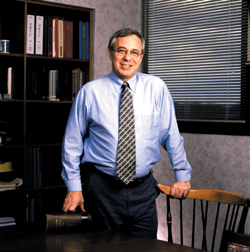
Alan D. Cherrington, Ph.D., chair of the Department of Molecular Physiology & Biophysics, is also president of the American Diabetes Association.
photo by Dean Dixon
Cherrington leads diabetes association in fighting obesity
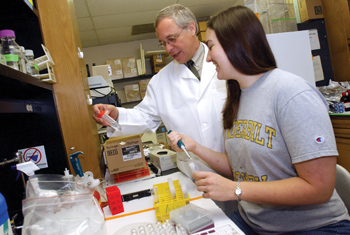
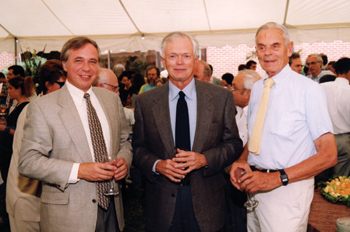
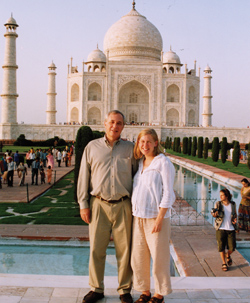
During a visit to India last month, Cherrington was accompanied by his daughter, Andrea Cherrington, M.D., (shown here in front of the Taj Mahal) and several other family members. Cherrington and her husband, Michael Mugavero, M.D., are expecting their first child in December.
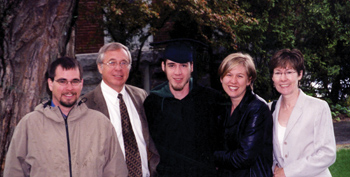
The Cherrington family in 2003: From left, Brian, Alan, Kevin, Andrea and Deborah at Kevin’s college graduation.
For more than 30 years, Alan D. Cherrington, Ph.D., has dedicated his career to solving the mysteries of diabetes. In June, he attained another milestone when he began his term as the first non-M.D. to hold the position of president of the American Diabetes Association.
Cherrington, who is chair of the Department of Molecular Physiology & Biophysics and Charles H. Best Professor of Diabetes Research at Vanderbilt University Medical Center, has made major contributions to current understanding of diabetes.
But he's not sitting on his laurels. Far from it. In addition to his administrative and research responsibilities at Vanderbilt, Cherrington is traveling the globe in his capacity as ADA president to raise awareness about the dramatically rising tide of diabetes worldwide.
In September, he attended a major diabetes research meeting in Chennai (Madras), India, and spoke with that country's health minister. Due largely to its rapid urbanization, India now leads the world in the incidence of diabetes, followed by China and the United States. “It's increasing everywhere,” he said.
Cherrington's trip was part of a growing emphasis at the ADA to help doctors, scientists and public health officials throughout the world improve the care and wellbeing of people with diabetes.
“By doing so, we're really goodwill ambassadors for the country, too,” he said. “An amazing number of people in India came up to talk about our country, and our role in the world.”
Cherrington is passionate about the work of the ADA, one of the nation's leading supporters of diabetes research, education and patient care. He says the organization must decide how it will address the epidemic of obesity, a major risk factor for the development of diabetes.
“In this country now, two out of three people are overweight, and one out of three is obese,” he said. “Are we going to become a diabetes/obesity organization? Are we going to set up a separate obesity organization?
“Really at this point it's not clear to me which is the correct course. I just know we have to do something, and we have to do it quickly.”
A Vanderbilt faculty member since 1974, Cherrington worries that the country's investment in biomedical research is lagging. Responding to the budget deficit and the cost of the war in Iraq, Congress has put the brakes on increased funding for the National Institutes of Health. “That will undoubtedly impact diabetes,” he predicted.
“There is no way that we can take the money that we are expending elsewhere, and still fund the NIH properly,” Cherrington asserted. “Choices have been made, and the consequence of those choices is less NIH funding, and the consequence of that will be less research and reduced speed of discovery.”
The government is not the only source of research funding, and Cherrington said he is committed to increasing the annual support provided by the ADA. “Right now we commit $40 million a year to research on all aspects of diabetes,” he said. “I would like to see it increase by $5 million this year.”
When asked about Cherrington's leadership, Richard Kahn, Ph.D., Chief Scientific and Medical Officer of the ADA, was unreserved. “He's a superb person,” Kahn said, “very even-keeled, contemplative, a critical thinker … somebody who is able to quickly grasp the issues and the nuances related to it, and is able to sort out a direction among conflicting claims.”
Cherrington's major contribution as president “unquestionably is going to be to lead us in the direction we should take regarding our work in the obesity arena,” Kahn said. “Clearly we have benefited from his insight and perspective, his grasp of the issue.”
A native of England who grew up in Canada, Cherrington earned his Ph.D. in physiology from the University of Toronto in 1973. He was on his way to Switzerland for a post-doctoral fellowship when Charles “Rollo” Park, M.D., then chair of Physiology at Vanderbilt, phoned him up and urged him to come to Nashville instead.
Park had met Cherrington during a visit to the University of Toronto, and Cherrington, in turn, was well aware of Vanderbilt's research powerhouse, which included some of the world's leaders in cell signaling and hormone action.
“I was flattered by that offer,” he said. “So I came here and paid a visit, and was just totally enamored by what I saw.”
Push-pull system
Cherrington turned down Switzerland for the chance to go to Vanderbilt, and soon found himself wrestling with the mysteries of diabetes.
“The thing which made the biggest impression on me was that when he came here as a young post-doc, he had a program in mind … to study the role of the hormones insulin and glucagon,” recalled Park, professor emeritus of Physiology. “He has demonstrated in a most clear-cut way the interplay of glucagon and insulin in controlling levels of blood glucose.
“I don't remember giving him any advice,” Park said, “but I gave him plenty of encouragement because I liked what he was doing.”
Insulin, secreted by beta cells in the pancreas, moves glucose from the bloodstream into muscle, where it can be burned for fuel. It can also slow glucose production by the liver.
Glucagon, another pancreatic hormone, opposes the action of insulin on the liver. It can speed up glucose production in situations where the demand for glucose by the body has outstripped its supply. Epinephrine (adrenaline), the “flight or fight” hormone released by the adrenal gland, has a similar action.
Over the years, Cherrington's work has helped define how the nervous system, insulin and glucagon can affect glucose production and glucose uptake by the liver.
This push-pull system is designed to keep blood glucose levels in balance, even after a feast, a fast or flight from a predator.
“When you eat, you store glucose in the liver,” Cherrington explained. “You ration it back out when you don't eat. We're looking at the hormonal and neural signals that control these processes, and how they may become dysfunctional in the diabetic state.”
In recognition of his scientific achievements, Cherrington has received the Lilly and Banting awards, two of ADA's top honors, as well as the David Rumbough Award from the Juvenile Diabetes Research Foundation.
“Alan Cherrington was the reason I came to Vanderbilt,” said Stephen N. Davis, M.D., who arrived from England in 1988 for a one-year fellowship to learn experimental techniques. “The work went so well, and Cherrington's lab was such a vibrant, exciting and fun place to be, that I stayed on,” he added.
Davis, who joined the faculty in 1991, is now chief of the Division of Diabetes, Endocrinology and Metabolism, and Rudolph Kampmeier Professor of Medicine and Molecular Physiology & Biophysics.
“Alan is a brilliant scientist,” Davis said. As a trainee, “you really feel you're contributing to answering important questions in diabetes. He's had a tremendous influence on the careers of a lot of successful scientists.”
In addition to their basic research, Cherrington and his colleagues work with pharmaceutical and biotechnology companies to help develop better ways of testing blood glucose and delivering insulin. They currently are testing modified insulin molecules that can be swallowed as a pill or inhaled, and which could free patients from the need for insulin injections.
Cherrington recently visited with a California company, Medtronic MiniMed, which is developing a “closed loop” system that would free patients from having to give themselves insulin injections, or finger sticks to check their blood glucose level.
The system consists of a glucose sensor that feeds information about blood glucose levels to an implantable insulin pump. The pump's computerized “brain,” in turn, determines how much insulin is needed to control blood glucose levels without causing hypoglycemia (low blood glucose) and its potentially life-threatening complications.
Within five years, closed loop systems may be available for patients who are unable to control their blood glucose because of frequent episodes of hypoglycemia, Cherrington predicted.
A balanced life
Cherrington said he has had several offers over the years to move elsewhere, “but I just could never match the academic opportunity here, nor the lifestyle.”
An avid gardener and golfer, he relishes the ability to pursue his recreations nearly all year round. He coached his sons' hockey teams for several years, and is an ardent supporter of the Nashville Predators. Most importantly, Cherrington said, Nashville is a good place to raise a family.
Cherrington and his wife of 36 years, Debbie Cherrington, R.N., M.S.N., met when they were in high school, and married after she received her nursing diploma from the Montreal General Hospital School of Nursing and before he began his graduate studies.
She later earned her bachelor's and master's degrees in nursing from Vanderbilt. Debbie is a former nursing supervisor at St. Thomas Hospital and recently retired from a teaching position in the Aquinas College nursing program.
They have three children: Andrea, 33, a 1999 graduate of Vanderbilt University School of Medicine; Brian, 30, who is working on his Ph.D. in reproductive biology at Colorado State University; and Kevin, 25, a counselor in an adolescent group home in Denver.
Andrea's husband, Michael Mugavero, also earned his medical degree from Vanderbilt in 1999, and currently is a fellow in infectious diseases at Duke University School of Medicine.
“Growing up, he always had time for us, no matter what the question, sport or activity,” said Andrea, currently an instructor in Medicine and a Robert Wood Johnson Clinical Scholar at the University of North Carolina.
“This has been extremely important in forming the person I am now, as well as how I will proceed in striking my own balance between career and family,” she said.
At the same time, “he would always tell us: 'Make sure you're doing something you enjoy, something that you look forward to when you wake up in the mornings.'
“My father has always seemed to enjoy what he does,” Andrea Cherrington said. “I think that he enjoys the intellectual challenges, the relationships he has formed and the impact that is possible through a career in research and teaching … As you mature, you need to take on new challenges and set new goals in order to stay fresh.
“My dad has certainly done that this year … I am very proud of him.”
Cherrington says he first got involved with the American Diabetes Association through Oscar B. Crofford, M.D., professor emeritus of Medicine who established the Division of Diabetes at Vanderbilt, served as ADA president in 1981-82, and directed the Diabetes Control and Complications Trial, a landmark national study that established the value of rigorous blood glucose control a decade ago.
“My initial association with the organization was two-fold,” Cherrington recalled. “They provided my first-ever (diabetes) research grant, and the president of the organization provided a letter of support, which allowed me to become an American resident and pursue my career here at Vanderbilt.”
Recently, Cherrington became an American citizen.
In the early 1980s, Cherrington served on the association's research review committee, which evaluates proposals for funding diabetes research projects. He went on to serve in a variety of capacities in the organization. Most recently, he was the vice chair of the ADA Research Foundation, and two years ago he became a member of the organization's national executive committee.
Strengthening ties
"No one has made a greater contribution to the Vanderbilt diabetes program and to the national fight against diabetes than Alan Cherrington,” Crofford said. “His research … has been a model of clear thinking and skillful research design. He is a gifted speaker and can describe his research findings so that both a scientific and a general audience can understand and appreciate its significance. This is no easy task.
“As a teacher for medical students and graduate students, Alan has a way of making science exciting. Very few members of the Vanderbilt faculty have inspired more medical students to explore a career in science.
“And finally, his service to the American Diabetes Association and to the Juvenile Diabetes Research Foundation is unprecedented,” said Crofford, who retired in 1995.
“All people with diabetes are indebted to him for his years of service to both of these voluntary health organizations. I feel deeply honored to have been his friend and colleague during most of my years at Vanderbilt.”
Overseas trips are not unusual for ADA presidents, but one of Cherrington's goals is to increase international collaboration.
In the past few months, “I've been to Canada because we're looking to strengthen our ties with the Canadian Diabetes Association,” he said. “We're also going to strengthen our ties with the Mexican Diabetes Association so that we have more of a North American approach to the problem.
“The ADA can help those organizations, and we can learn from them too.”
Several of Cherrington's family members accompanied him on the trip to India. They visited a large diabetes clinic in Madras, which has 100,000 patients in its registry. The care provided for indigent people just “scratches the surface” of what is needed, he said.
During their meeting, India's Union Minister for Health and Family Welfare, Anbumani Ramadoss, who is a physician, told Cherrington that his country's burden of diabetes and pre-diabetes is expected to more than double to about 200 million people by 2025.
In comparison, an estimated 60 million people in the United States now have diabetes or pre-diabetes, but that number also is expected to double in the next two decades.
“The impact of diabetes on the Indian economy is so profound that (Ramadoss) was telling me they are going to change their primary health care focus from infectious disease to chronic disease, which is amazing,” Cherrington said.
While the Madras clinic had the latest equipment and techniques for diagnosing and treating diabetes, “the problem is of course that people have to pay for it and they don't have the money,” he said.
The United States faces a similar dilemma. While it may be one day possible to cure diabetes through transplants and technologies like closed loop systems, the more cost-effective approach is to prevent people from developing the disease in the first place.
“The goal is to be able to identify people who are at risk,” Cherrington said. “That's step number 1. Step number 2 is to recognize when the disease begins, because being susceptible does not necessarily mean you're going to develop the disease.”
A recent national study, called the Diabetes Prevention Program, showed that moderate exercise and weight loss over a three-year period reduced by 58 percent the incidence of type 2 diabetes in people at high risk for developing the disease.
“There's a huge message in that,” Cherrington said. “Ninety-five percent of the people (with diabetes) are type 2. They would all benefit tremendously from moderate exercise and moderate weight loss. The impact of that socioeconomically is incredible.”
The problem is, “how do you get people to exercise and diet?” he asked. “It's great that we know it makes a difference. But now, how do you get them to do it?”













